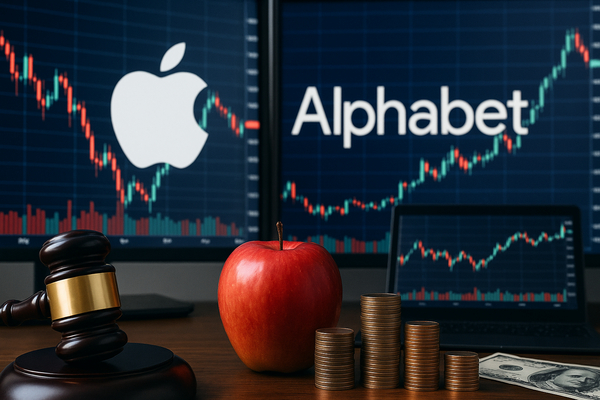
Apple hit with a $634 million patent verdict. The jury decision against Apple Inc. (NASDAQ:AAPL) over blood-oxygen smartwatch features and Berkshire Hathaway’s (BRK.B) surprise stake in Alphabet (NASDAQ:GOOGL) are driving market attention today. In the short term this raises legal and product‑roadmap questions for device makers. In the long term it highlights a broader tech-era risk mix: legal exposure, heavy AI investment, and large-scale corporate capital moves. The news matters globally — regulators in Europe and courts in the U.S. will watch legal fallout, while U.S. fiscal moves and corporate bond markets respond to big financings. Compared with past tech cycles, corporate balance sheets and buybacks are larger, and AI spending is accelerating faster.
Legal shock to consumer tech: the Apple verdict and what it signals
The federal jury in California awarded Masimo (NASDAQ:MASI) roughly $634 million, finding that certain Apple Watch features infringed Masimo patents. That ruling landed while Apple was already in the middle of succession talks and product changes after AI-centric launches. The immediate market reaction reflected both sector sentiment and a practical question for Apple: how will product software and hardware evolve to avoid repeat exposures?
Legal risk has long been part of the technology business. Yet this verdict is significant for three reasons. First, damages are material enough to draw boardroom attention at a $4 trillion company. Second, the award underlines how wearable health features intersect with regulated medical and IP regimes. Third, it sharpens a debate investors have watched for months: how much legal downside is priced into premium consumer hardware names?
Big capital moves: Berkshire’s Alphabet stake and Amazon’s bond push
Warren Buffett’s Berkshire Hathaway (BRK.B) disclosed a meaningful position in Alphabet (NASDAQ:GOOGL). The buy signals a renewed institutional comfort with large-cap tech beyond the usual AI bellwethers. For markets, that matters now because it changes the marginal buyer set for megacap names and tempers some valuation anxieties that surfaced after recent profit-taking.
Meanwhile Amazon.com (NASDAQ:AMZN) is preparing to sell $12–15 billion of U.S. bonds to fund AI infrastructure and other uses. Heavy corporate borrowing for AI capex is reshaping credit flows. Bond supply can tighten risk premia elsewhere. Put together, Berkshire’s equity move and Amazon’s debt sale reveal two ways large firms are allocating capital: equity accumulation by long-term holders and fresh debt to fund an AI buildout.
AI spending, semiconductors, and the market’s narrower battleground
Investors have rotated toward AI leaders. Nvidia (NASDAQ:NVDA) remains central, but chips and networking companies across the supply chain are in focus. Broadcom (NASDAQ:AVGO) drew upgrades on its AI positioning. Advanced Micro Devices (NASDAQ:AMD) saw analyst upgrades after bullish guidance from an analyst day. Those names have outsize influence on indexes and on investor psychology.
That concentration matters now because macro data are starting to return after a government shutdown paused releases. With key employment reports and manufacturing data due, traders must weigh macro momentum against the near-term cadence of AI capital expenditure. In prior cycles, when hardware megacaps faced either legal setbacks or regulatory scrutiny, broader sector multiple expansion paused. The current environment mixes strong cash generation with record capex plans, creating a high-stakes test of margin durability.
Political turbulence and market policy risk
On the Hill, political dynamics are turning more unsettled. Progressive groups have pressed for change in Senate leadership, creating undercurrents inside the Democratic conference. In the House, President Trump’s reversal on the Epstein discharge petition undercut Speaker Mike Johnson’s strategy and shifted votes unexpectedly. Those developments matter to markets because they affect the legislative calendar for everything from defense procurement to trade and tech regulation.
Meanwhile, a primary bid against House Minority Leader Hakeem Jeffries signals intra-party pressure that could complicate messaging ahead of next year’s elections. Political uncertainty is not new to markets, but today it comes when markets are already pricing heavy capital cycles and when big corporate legal outcomes are landing. For credit markets and international investors, the combination raises the probability of episodic volatility in the near term.
What investors should watch next
- Legal follow-ups and appeals in the Masimo‑Apple case. Watch court filings, the scope of injunction language, and any product software workarounds Apple announces.
- Corporate capital flows. Track Amazon’s (NASDAQ:AMZN) bond issuance size and pricing, and Berkshire’s filings for any follow-through purchases in Alphabet (NASDAQ:GOOGL) or other tech names.
- AI capex pacing. Monitor semiconductor order books and supply signals for Nvidia (NASDAQ:NVDA), AMD (NASDAQ:AMD) and Broadcom (NASDAQ:AVGO), and networking demand for Cisco (NASDAQ:CSCO).
- Political calendar. Note votes that could affect trade policy, defense appropriations, or tech regulation in the coming weeks.
The near-term picture is one of heightened cross‑currents: courts are imposing tangible costs, corporate balance sheets are shifting to finance AI scale, and politics is creating uncertainty over regulatory and fiscal outcomes. Over the longer term, the tech sector’s capacity to absorb legal risk while spending heavily on AI will determine whether this period becomes a temporary correction or a structural reset in valuations. Historically, the largest tech cycles combined rapid product adoption with low legal friction; today that balance is under test.
Investors will get more data soon. Employment and economic prints returning to the market schedule could either calm nerves or amplify volatility. For global markets, Europe and Asia will watch both the legal precedent and the flow of U.S. corporate capital, since cross-border partnerships and supply chains are integral to AI buildouts. Firms that rely on device features tied to medical or regulated functions now face a higher bar for IP clearance and regulatory coordination.
This is a moment when legal rulings, major capital moves, and political developments are intersecting with the AI cycle. Markets are pricing that intersection in real time. Observers should stay focused on public filings, court schedules, bond pricing, and the upcoming economic data releases that will influence both Fed narratives and investor risk appetite.












